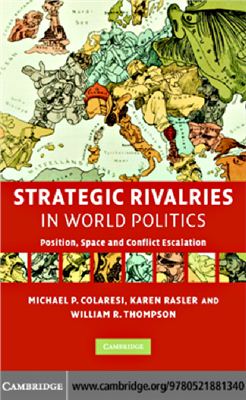Cambridge University Press, 2007. 314 p.
Inteational conflict is neither random nor inexplicable. It is highly structured by antagonisms between a relatively small set of states that regard each other as rivals. Examining the 173 strategic rivalries in operation throughout the nineteenth and twentieth centuries, this book identifies the differences rivalries make in the probability of conflict escalation and analyzes how they interact with serial crises, arms races, alliances and capability advantages. The authors distinguish between
rivalries conceing territorial disagreement (space) and rivalries conceing status and influence (position) and show how each lead to markedly different pattes of conflict escalation. They argue that rivals are more likely to engage in inteational conflict with their antagonists than nonrival pairs of states and conclude with an assessment of whether we can expect democratic peace, economic development and economic interdependence to constrain rivalry-induced conflict.
Michael P. Colaresi is Assistant Professor in the Department of Political Science at Michigan State University. Karen Rasler is Professor in the Department of Political Science at Indiana University.
William R. Thompson is Rogers Professor of Political Science in the Department of Political Science at Indiana University.
About strategic rivalries
An introduction to strategic rivalries
Defining and identifying strategic rivalries in world politics
Describing strategic rivalries
The dangers of strategic rivalries: Crisis behavior and escalation
Protracted conflict and crisis escalation
Serial crisis behavior and escalating risks
Playing to type: Spatial and positional issues in strategic rivalries
Contiguity, space and position in the major power subsystem
Initiating and escalating positional and spatial rivalries
Filling in some steps to war
Arms build-ups and alliances in the steps-to-war theory
Contested territory and conflict escalation
Strategic rivalries and conflict
Inducements, facilitators, and suppressors
Inteational conflict is neither random nor inexplicable. It is highly structured by antagonisms between a relatively small set of states that regard each other as rivals. Examining the 173 strategic rivalries in operation throughout the nineteenth and twentieth centuries, this book identifies the differences rivalries make in the probability of conflict escalation and analyzes how they interact with serial crises, arms races, alliances and capability advantages. The authors distinguish between
rivalries conceing territorial disagreement (space) and rivalries conceing status and influence (position) and show how each lead to markedly different pattes of conflict escalation. They argue that rivals are more likely to engage in inteational conflict with their antagonists than nonrival pairs of states and conclude with an assessment of whether we can expect democratic peace, economic development and economic interdependence to constrain rivalry-induced conflict.
Michael P. Colaresi is Assistant Professor in the Department of Political Science at Michigan State University. Karen Rasler is Professor in the Department of Political Science at Indiana University.
William R. Thompson is Rogers Professor of Political Science in the Department of Political Science at Indiana University.
About strategic rivalries
An introduction to strategic rivalries
Defining and identifying strategic rivalries in world politics
Describing strategic rivalries
The dangers of strategic rivalries: Crisis behavior and escalation
Protracted conflict and crisis escalation
Serial crisis behavior and escalating risks
Playing to type: Spatial and positional issues in strategic rivalries
Contiguity, space and position in the major power subsystem
Initiating and escalating positional and spatial rivalries
Filling in some steps to war
Arms build-ups and alliances in the steps-to-war theory
Contested territory and conflict escalation
Strategic rivalries and conflict
Inducements, facilitators, and suppressors

